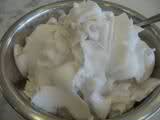 Coconut meat or buko meat can be processed into many food products and one of them is the coco or buko candy. Processing a coco meat into candies mean a lucrative, income-generating business for individuals especially work at home moms, out-of-school youth, and students.
Coconut meat or buko meat can be processed into many food products and one of them is the coco or buko candy. Processing a coco meat into candies mean a lucrative, income-generating business for individuals especially work at home moms, out-of-school youth, and students.
The making of coco or buko candy involves several stages:
1. Seven to nine months old coconuts are gathered. They are cut in half with a bolo. Meat is removed from the shell with an improvised scraper.
2. The meat is then cleaned, washed and sliced into small rectangular pieces. The only machinery used is a grinder which grounds the sliced meat.
3. After grinding, the meat is cooked for two to three hours in a mixture of cassava flour and “tawas”, which is used as preservative.
4. After cooking, the buko is allowed to cool. When cool, it is shaped into spheres, which are then rolled in sugar. The candies are finally packed into plastic bags.
Note: Exact measurements of the ingredients are not listed. You can do experiments to suit your needs.
Source: The Filipino Entrepreneur magazine
Do you like this business idea? content“> then please consider subscribing to our PINOY BISNES ![]() RSS feed. You can also subscribe by email and have new articles sent directly to your inbox. (Once you entered your e-mail address, you need to login to your e-mail account and click the link to confirm your subscription).
RSS feed. You can also subscribe by email and have new articles sent directly to your inbox. (Once you entered your e-mail address, you need to login to your e-mail account and click the link to confirm your subscription).




Just want to ask if “tawas” is not dangerous to health…
Alum or the common term “tawas”. Here’s the answer.
“Alum is a salt that in chemistry is a combination of an alkali metal, such as sodium, potassium, or ammonium and a trivalent metal, such as aluminum, iron, or chromium. The most common form, potassium aluminum sulfate, or potash alum, is one form that has been used in food processing. Another, sodium aluminum sulfate, is an ingredient in commercially produced baking powder. (Have you never noticed the faint metallic taste in baking powder? It comes from the alum.)
The potassium-based alum has been used to produce crisp cucumber and watermelon-rind pickles as well as maraschino cherries, where the aluminum ions strengthen the fruits’ cell-wall pectins.
Alum is approved by the U.S. Food and Drug Administration as a food additive, but in large quantities — well, an ounce or more — it is toxic to humans. As a result, efforts have been made and are being made to wean us of our alum dependency. The U.S. Department of Agriculture says that if good quality produce and modern canning methods are employed, there is no need to use alum to bolster the crispness of our pickles and cherries. In any event, the department says, even if alum is used to soak the pickles, it should not be used in the final pickling liquid.”
—Source: http://www.ochef.com/1080.htm
In cooking coco candy, you can omit the use of “tawas” if you don’t know how to use it. “Tawas” here is just a preservative.
that’s so yummy dude.I think I can make like that.HAHAHha
James | vac